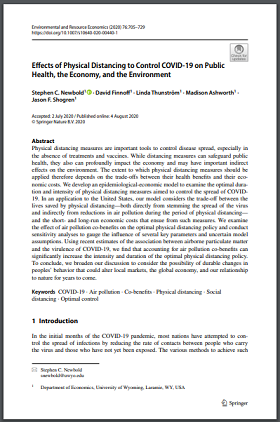
Physical distancing measures are important tools to control disease spread, especially in the absence of treatments and vaccines. While distancing measures can safeguard public health, they also can profoundly impact the economy and may have important indirect effects on the environment. The extent to which physical distancing measures should be applied therefore depends on the trade-offs between their health benefits and their economic costs. We develop an epidemiological-economic model to examine the optimal duration and intensity of physical distancing measures aimed to control the spread of COVID19. In an application to the United States, our model considers the trade-of between the lives saved by physical distancing—both directly from stemming the spread of the virus and indirectly from reductions in air pollution during the period of physical distancing— and the short- and long-run economic costs that ensue from such measures. We examine the effect of air pollution co-benefits on the optimal physical distancing policy and conduct sensitivity analyses to gauge the influence of several key parameters and uncertain model assumptions. Using recent estimates of the association between airborne particulate matter and the virulence of COVID-19, we find that accounting for air pollution co-benefits can significantly increase the intensity and duration of the optimal physical distancing policy. To conclude, we broaden our discussion to consider the possibility of durable changes in peoples’ behavior that could alter local markets, the global economy, and our relationship to nature for years to come.














